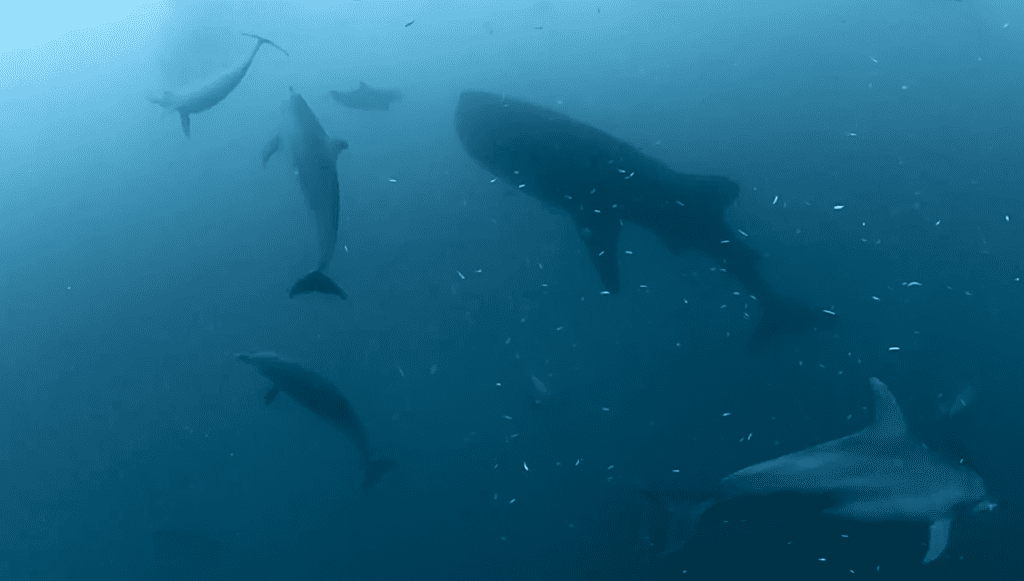Whale sharks and dolphins “together” in Triton Bay
Recently visitors to Triton Bay’s “Whale Shark Experience” have been gifted with a bonus…the presence of dolphins! While this is not necessarily an event exclusive to Triton Bay, it is significant enough that Konservasi Indonesia’s, “Focal Species Conservation Senior Manager”, Iqbal Herwata, will soon release a detailed manuscript on their interactions in the area.
There are numerous questions surrounding this unusual event, “Are the two species seeking each other out? Are they interacting? Are they cooperating or are they competing for the same food source? How does this impact tourism in Triton Bay and how will increasing tourism impact these marine species?
Iqbal’s research seeks to answer these questions and more!
Iqbal has kindly given me permission to share some highlights from his forthcoming manuscript:
“Our findings demonstrate that the Indo-Pacific bottlenose dolphin is the only species that has a strong association with lift net fishery feeding behavior. Although other species have been seen feeding around the lift net fishery, they are not as common as the Indo-Pacific bottlenose dolphin.
Lift net fisheries operations began in Kaimana in 2000, primarily at the mouth of Bicari Bay (located near the NW corner of Triton Bay), with the target of selling anchovies and other baitfish to markets and supplying the pole and line fishing industry in the Kaimana area. The seemingly high productivity of the bay draws year-round lift net fishery operations to the area.
The process of capturing baitfish attracts whale sharks and dolphins to the fishing vessel, known locally as bagans, and they frequently feed on the fish before they are caught in the net.
This interaction has created unique opportunities for the establishment of provisioning-based whale shark and dolphin watching industries. Fishermen and tour operators use anchovies as bait to attract and encourage the sharks and dolphins to remain close to the lift-net fishery boat. This suggests that both sharks and cetaceans likely have a natural preference for hunting anchovies. The coexistence of passive provisioning through the presence of lift-net fisheries and active feeding driven by tourism has led to the development of distinctive behavioral and ecological adaptations in their foraging strategies.”
I have reached out to a couple of additional colleagues for their opinions:
“I’ve certainly seen the whale shark/dolphin interaction the last few times I’ve been in Triton Bay, but I will be honest that I don’t know that this is a situation of whale sharks and dolphins seeking each other out. The interaction ONLY happens when there is a lot of food in the water and the dolphins come in to feed on the baitfish, in essence “competing” with the whale sharks. Over the years I’ve seen the dolphins in Triton Bay get more or more acclimatized to humans, such that now you can actually see the dolphins underwater at same time as whale sharks. In the early days you would occasionally hear the dolphins pinging underwater and see them from the surface feeding around the whale sharks, but they would disappear the moment that humans got in the water.
I would be a bit dubious if the claim is that whale sharks and dolphins are actively interacting/seeking each other out. I’m open to have my mind changed, but my personal observations suggest it is more a situation of targeting the same food source, much like what happens when you get bait balls with multiple predator species or oceanic mantas and bryde’s whales (or omura’s whales) both targeting same krill swarms, etc…”
” In the first couple of years after we opened the resort, there were no dolphins around when we visited the bagans for the whalesharks.
By year 3 the dolphins could be heard underwater and seen at the surface but didn’t come close.
By year 4 they started to understand the divers and snorkelers wouldn’t hurt them and that there was free fish available that the whale sharks had not gobbled up and so they would come in deeper down and eat up the excess fish. Still a little shy.
In the last few years they have gotten braver and braver – depending on the species of dolphin – and now they come super close to the divers and the whale sharks, as you can see on some of our videos. It is an amazing experience!”








































